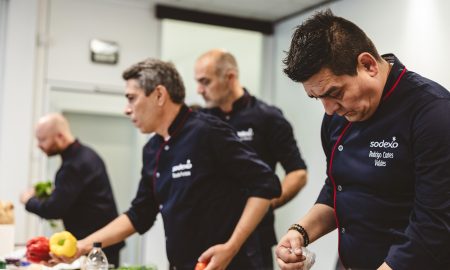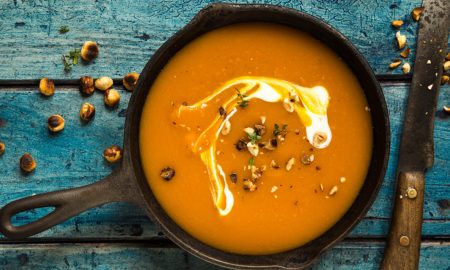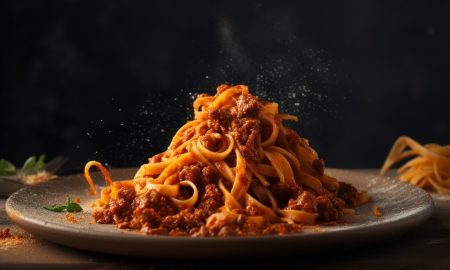It never fails: each new year brings us a fresh crop of food trends that are supposedly the Next Big Thing. Cheese tea… THC food… somebody’s always hyping something somewhere, talking about it like it will change the culinary landscape forever. And then after a while, it fades away as quickly as it came. Yeah, food trends can be kind of obnoxious. At the same time, though, they’re a really interesting phenomenon, and restaurant professionals aren’t the only ones who learn a lot by analyzing them. You have to go about it the right way, though.

Image: Monika Reiter – Rolling Pin
Proper food trend analysis isn’t about tabloid-style crystal ball speculation—it’s about serious critical thinking, about looking at why and how people’s nutritional choices are developing in which direction.
As it happens, one of the true greats in the field of scientific food-trend analysis is right here in the German-speaking world. Hanni Rützler, founder of the futurestudio in Vienna, is one of the most respected researchers in her field. She also writes the annual Food Report, which is published by the Future Institute. Even those who may not be familiar with Rützler’s groundbreaking research might know her from that time she taste-tested a burger in public—and became the first person in the world to eat meat cloned from stem cells. But let’s not get ahead of ourselves here (though it’s hard to avoid when you’re talking about the future): In order to understand how food trends come about, we have to start with the question of what exactly a food trend is.
You are what you eat
“I’m not interested in product trends,” Rützler says. “A lot of them change seasonally, sometimes even faster than that. What I’m more interested in are changes in consumer trends, so to me food trends are really intriguing when they involve responding to current problems, needs or desires. In terms of substance, there really needs to be a visible transformation—a solution-oriented transformation, that is.” Oftentimes, trends are first perpetuated by a small group, whether it’s culinary-minded elites or money-minded companies who are trying to make a certain trend palatable to the masses in order to fill a gap in the market. But for something to qualify as a genuine trend, it has to be more than just an ingredient getting a lot of hype, or a product that’s in everyone’s breakfast Instagram shots for one season.
You might say that food trends reflect more than just what people are eating more of, or what they’re planning to eat more of in the future. Ultimately, they express developments in society that have a major influence on something deeply personal, private, even intimate: how we eat. Wait a minute, though. Is food really personal, private, and intimate? Well, nowadays, it’s definitely not. One aspect of understanding serious food trends scientifically is the idea that eating is about much more than just the “intimate” act of putting food into our bodies— what we eat has become a way for us to express a certain lifestyle. Nutrition is a kind of test-tube distillation of a person’s personality with all its many external contexts. As Rützler’s 2016 Food Report puts it, “Food is the new pop.” Our dining choices have become as public and as visibility-oriented as our clothing. We’ve all heard “clothes make the man,” but “you are what you eat” may have become the more relevant adage. At first glance, food trends seem perfectly neutral, a harmless source of pleasure. In reality, though, they’re the only concrete way of discovering, tracing, and ultimately even predicting systematic culinary transformation.

Image: Monika Reiter – Rolling Pin
15 minutes of fame aren’t enough
“I think we’ve definitely reached a point of food excess, and the millennial and post-millennial generations are learning to respond to that excess in a different way. In general, they’re calling a lot of developments into question. That includes issues of health, ecology, enjoyment and taste, but more and more it’s coming to be about the big issue of sustainability.” Rützler’s explanation gives us a bit more insight into the process of distilling food trends scientifically. It’s not about whether people are eating more of one specific herb or seed, whether this vegetable or that fruit is all the rage for a few months and then disappears to the back of the produce section again after its fifteen minutes are up. More than anything, it’s about overarching societal phenomena that produce not only desires, but ideas, business models, products… and, ultimately, trends. Obviously, these overarching phenomena don’t all exist in perfect harmony, and they certainly don’t just result in hype about this or that particular product. In fact, many products are perfect examples of how these phenomena are often at odds with one another.
The long, hard road to healthy eating
Health and sustainability are two major themes in the food trends we’ll be discussing in a moment. But foods that are healthy aren’t automatically sustainable, and vice versa. Take the recent avocado craze, for example, which started with a small group of health fanatics who put the fruit on a pedestal for its impressive nutrient contents (keyword: health). Now many of them are startling awake from their guacamole-hued fever dreams, horrified at the growing realization that mass consumption of avocados is terrible for the environment (keyword: sustainability, sub-topic: rainforest). Whether you’re on Team Avocado or not, though, there’s no denying one thing: Overall, more and more of today’s food trends are developing “for morally or ethically motivated reasons,” Rützler notes. This year’s Food Trend report highlights one notable and increasingly popular exception to that rule: “healthy hedonism.” In other words: eating healthy and loving every minute of it. Consumers seem to be turning away from the long-held notion that “good for you” diets are all about self-denial, choosing instead to take the more pleasant (and more practical) view that being healthy doesn’t necessarily mean sacrificing enjoyment (or vice versa). As Rützler’s 2019 Food Report puts it, “When vegetables and vegetable-based dishes are touted as ‘healthy’, people enjoy eating them far less than when they appeal to our culinary tastes (‘delicious butter-roasted sweet corn’, ‘citrus-glazed carrots’), thereby bridging the gap between health and pleasure both linguistically and mentally.”

Image: Monika Reiter – Rolling Pin
Plant superstars
The healthy hedonism trend is closely associated with another trend mentioned in Rützler’s report: the “plant-based food” trend. Here, too, the focus is on solution-oriented enjoyment rather than self-denial. “This is about a very broad range of culinary uses for plant-based foods,” Rützler says. “I was trying to trace evolution of the trend: how veganism – a highly publicized and morally poralizing subject, which we’ve been studying a lot over the past five years now – is now transforming into something more mainstream.” Indeed, the idea of “plant-based” eating is difficult to separate from veganism. The difference isn’t just one of terminology, though. Granted, the term “plant-based food” has less of a radical-ascetic ring to it, with fewer political connotations than “veganism”, but it also stands for a different, more forgiving approach: “Plant-based can also mean dishes where vegetables and grains play the main role, while meat and fish are minor, but welcome side dishes,” Food Report says. In other words, militant meatless moralizing is totally last season. As a result, perhaps, plant-based eating doesn’t really emphasize the commercially available imitations of animal products— the beans, grains, veggies, and herbs themselves are the stars of the show. Or as Rützler puts it: “From ‘tastes like’ to ‘tastes great!’” To some extent, Rützler says, haute cuisine likely had a hand in paving the way for this ever-growing phenomenon; she points to Alain Passard’s Arpège in Paris and Heinz Reitbauer’s Steirereck in Vienna, “both of whom make vegetables the stars on their plates.”
A new love of meat
The culinary rediscovery of vegetables (which Rützler described as a “Copernican Revolution” in 2018) resulted in another trend known as “peak meat”. There’s an interesting logic to this development, one that can help shed light on the mechanisms behind how food trends come about. As Rützler explains in her research report, each trend leads to a counter-trend, though the second might not necessarily represent a direct negative reaction to the first. In fact, the counter-trend can end up being influenced by the original trend, transforming it as time goes on. In essence, plant-based food goes hand-in-hand with the long-term development of peak meat. According to Rützler, that’s because “what’s happening here is really the saturation of a historical phenomenon, and if the economy remains stable, we can presume that, over the long term, our tendency will be toward eating less meat, not more.” Looking at the trend towards new forms of meat consumption, it becomes clear that trends mutually influence one another, or are even interdependent in some cases: from the looks of it, in the future, we’ll be eating smaller quantities of higher-quality meat. “We are indeed seeing a new love of meat,” Rützler says. “And not just because there’s more organic meat around. In the future, there will be more of an emphasis on specific breeds of animals, on where the meat is from and what the animal is fed.” Here, too, this new love of meat has resulted in numerous offshoots: trends like those focusing on transparency, butchery, or regionalism underscore a new longing for “real storytelling,” as Rützler says – “in the sense that one genuinely creates a new story.”
Major resistance to be expected

Image: Monika Reiter – Rolling Pin
How does this desire for a story tie into the trend towards reduced consumption, and how do they both tie into the futuristic subject of in-vitro meat? Well, obviously, there are no definite answers there yet. “It’s such a big topic,” Rützler says, “that it may yet have to overcome some major resistance at some point. We have a few technological hurdles to get over as well. But people are so determined, and many of them see so much business potential there, that we simply can’t ignore it.” As evidence, Rützler points not only to the billions of dollars being pumped into the in-vitro business in the US, Israel, and China, but also to the previously mentioned overarching phenomena of sustainability, resource scarcity, and feeding the world.
Examples like these indicate just how precisely and thoroughly food trends need to be researched… and they also show that, if you dig deep like Hanni Rützler does and uncover the phenomena behind those trends, you can draw reliable conclusions on long-term future trends. Despite the fact that they’re often brought into the world through small groups of elites, food trends are more than just catchy nuggets of wisdom about random exotic products. Some catch on like wildfire; others fade away almost immediately. One thing’s for sure, though: there’s a lot more to food trends than just changing tastes.















